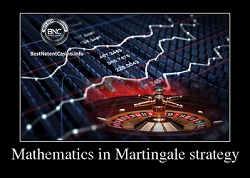Last Updated: Tuesday, 19 December 2023 10:50
Mathematics in Martingale strategy

The essence of the classic Martingale system
The Martingale strategy has been in existence since the second half of the 18 century. On this strategy, the bet amount should be doubled after a loss and lowered to the initial value after a win.
Example of using this scheme when playing roulette
- Play European roulette.
- The minimum bet is €1. Play on red.
- The first bet is lost, then put €2 on red.
- In the case of consecutive losses, the rate will rise to four dollars, eight, sixteen, thirty-two, and so on.
- If the bet won, the next stake would be €1 (initial value).
- The system allows one to get small winnings. Loss may be huge, though rare.
Disadvantages of the Martingale system
When using the classic version of the system, you may encounter several problems:
- Lack of funds for a new bet. In a series of 10 losses, the eleventh time should be 1024 minimum bets!
- Next bet might be more than the table limit.
- Psychologically it is difficult to double the bet continually. At a minimum rate of €1, we should play €2, €4, €8, €16, €32, €64, €128, €256, €512, €1024 and so forth.
- There is no such thing as infinite sequences, budgets and unlimited limits.
Calculating the mathematical expectation

In this case, the probability of losing the entire budget will be 0.5 at Nth degree, and of winning is 1 - (0.5 at Nth degree). Move on to the figures: the initial bet is €1, having a budget of N=10 bets, which are doubled every time — a total of €1023.
The probability of losing the entire budget
- The results of these ten tosses could be completely different: all coins' tails, all coin's heads, 5 coins tails, and 5 coins heads, etc. The total number of combinations is 1024.
- All outcomes have the same probability – 1/1024. Note that of all the possible results, the significant loss will happen at 10 consecutive heads.
- Hence, the probability of losing the entire budget is equal to 1/1024.
The probability of winning a bet
- The chance of winning after these 10 tosses, i.e. getting any other combination of outcomes (except for ten consecutive heads), is 1 - 1/1024 = 1023/1024.
- Therefore, the ratio of the probability of the loss of the total budget and winning is equal to 1/1024, divided by (1 - 1/1024) = 1/1023.
Zero mathematical expectation

A theoretically working system of betting
If you slightly change the strategy (after losing placing another bet equal to the total amount of loss plus X), at a certain value (more than a third of the amount of the first two bets), the mathematical expectation will be higher than zero. I.e. the system will work theoretically, provided the unrestricted sequence of betting and budget. But at an infinite number of bets and budget, the doubling should work using a classic version of the Martingale strategy. But only theoretically. In the real world, there is no such thing as unlimited budgets and limitless opportunities to increase rates.
Summary
Martingale system is a working system, but only theoretically. Even in the absence of zero and other ways of loss, you get a zero mathematical expectation. Moreover, especially against the players who use the Martingale system, the casinos set limits. If the minimum bet is €1, the maximum will be €100; Want to play bigger? Here it is: the maximum bet is €1000, the minimum will increase by 10 times (up to €10). In other words, often, you will not be able to increase the initial bet by more than 100 times.
Martingale as a scamming system
Scammers very often consider the Martingale system as an ideal opportunity for guaranteed winnings at the online casino. There are many websites and videos, where it is told about the ease of solid earnings: $200 per hour and more. Remember, small frequent winnings will be equal to one significant loss at a distance. But due to zero in Roulette or dealer's Blackjack, the system will be negative for player and positive for the casino.
Where to play?
- Do you want to try the Martingale system? At Fastpay casino, you can use any strategy you wish to in demo mode or real money play.
Play the best online casinos for money in 2024





